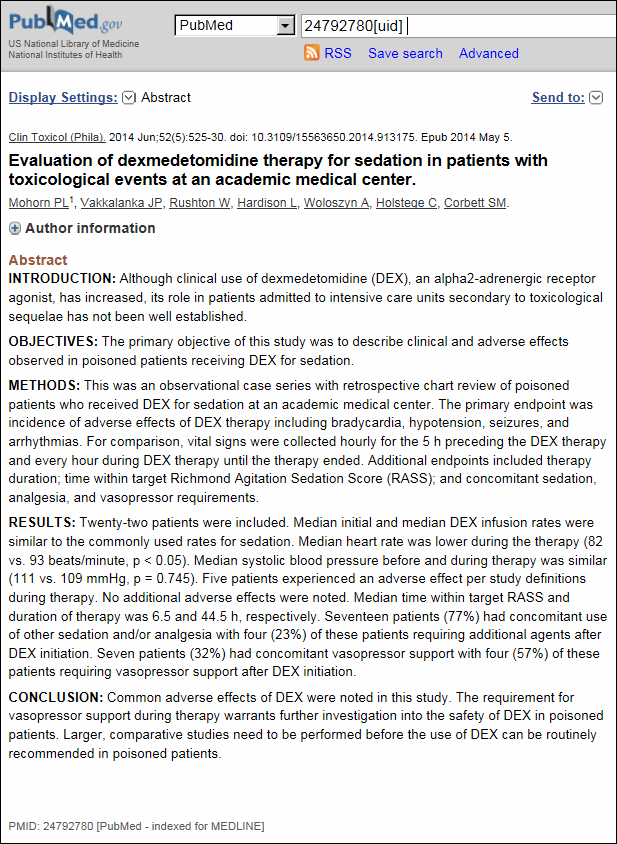Structured Abstracts
What are structured abstracts?
A structured abstract is an abstract with distinct, labeled sections (e.g., Introduction, Methods, Results, Discussion) for rapid comprehension (see Figure 1).

Figure 1: PubMed Abstract Display for a Structured Abstract.
What kinds of structures are used?
Standardized formats for structured abstracts have been defined for original research studies, review articles and clinical practice guidelines (1,2). The IMRAD format (INTRODUCTION, METHODS, RESULTS, and DISCUSSION), a defacto standard that reflects the process of scientific discovery (3), is commonly used as a structure for journal abstracts (4,5). The CONSORT (Consolidated Standards of Reporting Trials) Group issued a guideline for how to report randomized controlled trials (RCTs) in journal and conference abstracts using a structured format (6).
Why use structured abstracts?
Structured abstracts have several advantages for authors and readers. These formats were developed in the late 1980s and early 1990s to assist health professionals in selecting clinically relevant and methodologically valid journal articles. They also guide authors in summarizing the content of their manuscripts precisely, facilitate the peer-review process for manuscripts submitted for publication, and enhance computerized literature searching (1,2).
The International Committee of Medical Journal Editors (ICMJE, of which NLM is a sitting member), whose "Recommendations for the Conduct, Reporting, Editing and Publication of Scholarly Work in Medical Journals" document provides general guidelines for the format of manuscripts submitted to journals, requires the use of structured abstracts for original research articles, systematic reviews, and meta-analyses. ICMJE does acknowledge that the format required for structured abstracts differs from journal to journal and that some journals use more than one structure (7).
The substantial growth in both the individual number of PubMed records with structured abstracts and in the number of journals that continuously publish structured abstracts demonstrates widespread adoption of structured abstracts over the years (8). Structured abstracts perform better than unstructured abstracts for the discovery of corresponding MeSH (Medical Subject Headings®) terms using the Medical Text Indexer (MTI) software application (9). More information about NLM research on structured abstracts including technical details for the NLM implementation of structured abstracts can be found at Structured Abstracts in MEDLINE.
How are structured abstracts formatted in PubMed?
NLM uses all uppercase letters followed by a colon and space for the labels that appear in structured abstracts in MEDLINE/PubMed® citations (see Figure 1).
How can I search for structured abstracts in PubMed?
In a PubMed search box, type:
- hasstructuredabstract
See the structured abstract search results in PubMed.
References:
1. Haynes RB, Mulrow CD, Huth EJ, Altman DG, Gardner MJ. More informative abstracts revisited. Ann Intern Med. 1990 Jul 1;113(1):69-76. PubMed PMID: 2190518. Available from: https://www.acpjournals.org/doi/10.7326/0003-4819-113-1-69.
2. Hayward RS, Wilson MC, Tunis SR, Bass EB, Rubin HR, Haynes RB. More informative abstracts of articles describing clinical practice guidelines. Ann Intern Med. 1993 May 1;118(9):731-7. PubMed PMID: 8460861. Available from: https://www.acpjournals.org/doi/10.7326/0003-4819-118-9-199305010-00012.
3. Sollaci LB, Pereira MG. The introduction, methods, results, and discussion (IMRAD) structure: a fifty-year survey. J Med Libr Assoc. 2004 Jul;92(3):364-7. PubMed PMID: 15243643; PubMed Central PMCID: PMC442179.
4. Nakayama T, Hirai N, Yamazaki S, Naito M. Adoption of structured abstracts by general medical journals and format for a structured abstract. J Med Libr Assoc. 2005 Apr;93(2):237-42. PubMed PMID: 15858627; PubMed Central PMCID: PMC1082941.
5. Kulkarni H. Structured abstracts: still more. Ann Intern Med. 1996 Apr 1;124(7):695-6. PubMed PMID: 8607606. Available from: https://www.acpjournals.org/doi/10.7326/0003-4819-124-7-199604010-00020.
6. Hopewell S, Clarke M, Moher D, Wager E, Middleton P, Altman DG, Schulz KF; CONSORT Group. CONSORT for reporting randomized controlled trials in journal and conference abstracts: explanation and elaboration. PLoS Med. 2008 Jan 22;5(1):e20. PubMed PMID: 18215107; PubMed Central PMCID: PMC2211558.
7. International Committee of Medical Journal Editors. Recommendations for the Conduct, Reporting, Editing, and Publication of Scholarly Work in Medical Journals (ICMJE Recommendations). 2013 Aug [cited 2013 Aug 21]. Available from: http://www.icmje.org.
8. Ripple AM, Mork JG, Rozier JM, Knecht LS. Structured abstracts in MEDLINE: twenty-five years later. Bethesda, MD: National Library of Medicine; 2012 [cited 2014 Sep 17]. Available from: https://wayback.archive-it.org/7867/20241213202511/https://lhncbc.nlm.nih.gov/ii/areas/structured-abstracts/downloads/Structured_Abstracts_in_MEDLINE_Twenty-Years_Later.pdf.
9. Ripple AM, Mork JG, Thompson HJ, Schmidt SC, Knecht LS. Performance comparison of MEDLINE structured abstracts to unstructured abstracts. Poster session presented at: National Institutes of Health Research Festival; 2014 Sep 22-24; Bethesda, MD. Available from: https://researchfestival.nih.gov/festival14/poster-RSCHSUPP-19.html.
Last Reviewed: December 14, 2023


